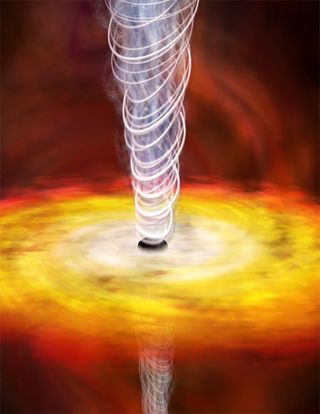
A new study finds that the supermassive black holes at the hearts of some galaxies are the most fuel efficient engines in the universe.
"If you could make a car engine that was as efficient as one of these black holes, you could get about a billion miles out of a gallon of gas," said study team leader Steve Allen of the Kavli Institute for Particle Astrophysics and Cosmology at Stanford University. "In anyone's book, that would be pretty green."
The finding, made using NASA's Chandra X-ray Observatory and announced in a media teleconference today, is giving scientists insights into how supermassive black holes generate energy and how they affect the galaxies where they make their homes.
'Quiet' black holes
Black holes are regions of space where gravity is so strong that matter and light can't escape once they pass the event horizon, a spherical boundary surrounding the black hole.
However, inflowing matter that hasn't yet passed this point of no return can-through friction and interaction with the black hole's strong magnetic field-release energy in the form of either diffuse light or focused jets of energy.
"Once gas comes within a distance about a million times larger than the event horizon of the black hole, it becomes gravitationally captured," Allen explained. "At this point the gas becomes fuel for the black hole engine."
Get the Space.com Newsletter
Breaking space news, the latest updates on rocket launches, skywatching events and more!
The new study looked at nine supermassive black holes at the centers of elliptical galaxies; each one was about a billion times more massive than our Sun. The black holes were relatively old and generated much less energy than the fiercely luminous and rapidly growing supermassive black holes known as "quasars."
The researchers found that these "quiet" black holes released about 1,000 times more energy as jets than as light. The reasons for this are still unclear.
"That's a mystery, how these black holes selectively put that much energy into the jets without producing much light," study team member Christopher Reynolds from the University of Maryland told SPACE.com.
Space bubbles
Most of the energy in the jets is being emitted as radio waves, but in at least one of the black holes studied, the energy was in the form of more energetic X-rays.
"The energy in these jets is absolutely huge, about a trillion trillion trillion watts," Allen said.
As they race outwards from their parent black holes at nearly light speed, the jets carve out enormous cavities, or "bubbles," in the surrounding gas environment; some of these bubbles can be tens of thousands of light years across.
Bubbles can also form in the aftermath of stellar explosions called supernovas; our own solar system is enveloped by such a structure, called the "Local Bubble," which was formed during an explosion long ago.
The researchers used these bubbles to figure out the fuel efficiency of the black holes. Using Chandra images, they first calculated how much fuel in the form of gas was available to each black hole. They then estimated the power required to produce the bubbles that were observed.
Preventing galactic sprawl
The finding could have implications for other types of black holes as well, including much smaller, stellar-mass black holes, the researchers say.
"We already knew that powerful quasars are very efficient at making light. Now we know that black holes in elliptical galaxies are efficient as well," said Kim Weaver, a researcher at NASA's Goddard Space Flight Center who was not involved in the study. "This suggests that being green is a trait that all black holes may have in common."
The scientists think the supermassive black holes are green in another way, too. The energy that each black hole emits as jets warms the surrounding environment. This prevents gas from cooling and coalescing into billons of new stars and places an upper limit on how large a galaxy can grow.
"In an environmental sense, the black holes are actually preventing galactic sprawl from taking over the neighborhood," Weaver said.
The study will be published in an upcoming issue of the Monthly Notices of the Royal Astronomical Society.
- Giant Bubble Bullies Our Space
- Quasar Jets Create Cosmic Pileups
- Black Hole Forges Invisible Bubble
- Animation: Slow Birth of a Black Hole
Join our Space Forums to keep talking space on the latest missions, night sky and more! And if you have a news tip, correction or comment, let us know at: community@space.com.
Ker Than is a science writer and children's book author who joined Space.com as a Staff Writer from 2005 to 2007. Ker covered astronomy and human spaceflight while at Space.com, including space shuttle launches, and has authored three science books for kids about earthquakes, stars and black holes. Ker's work has also appeared in National Geographic, Nature News, New Scientist and Sky & Telescope, among others. He earned a bachelor's degree in biology from UC Irvine and a master's degree in science journalism from New York University. Ker is currently the Director of Science Communications at Stanford University.
